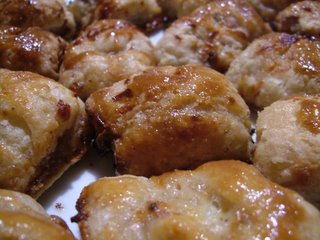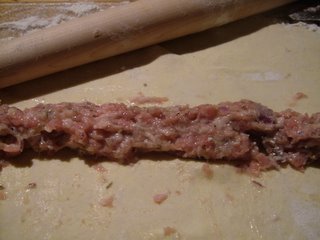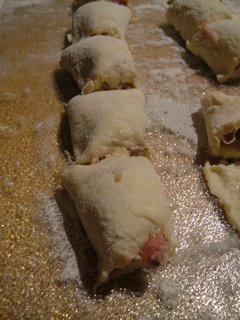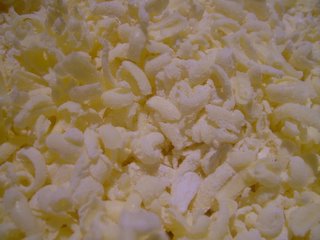 My Grandma’s second husband (yes, the Grandma with the salad cream) was a butcher in a town where they liked their meat cheap and homogenous. He had a sausage machine. In one end, he’d put pieces of elderly grey stuff which looked like precisely what they were – anatomy. He’d add a dehydrated, pre-bought rusk mix that he’d wetted overnight with some tepid tap water. He’d drop in a pellet of pink food colouring and a wodge of aging fat that he’d scraped off some of the meat he’d sold to the partially-sighted lady who thought she was buying topside. Sausages came out the other end, excreted by the burping machine into glistening, protein-condom skins.
My Grandma’s second husband (yes, the Grandma with the salad cream) was a butcher in a town where they liked their meat cheap and homogenous. He had a sausage machine. In one end, he’d put pieces of elderly grey stuff which looked like precisely what they were – anatomy. He’d add a dehydrated, pre-bought rusk mix that he’d wetted overnight with some tepid tap water. He’d drop in a pellet of pink food colouring and a wodge of aging fat that he’d scraped off some of the meat he’d sold to the partially-sighted lady who thought she was buying topside. Sausages came out the other end, excreted by the burping machine into glistening, protein-condom skins.
The thing I still, all these years later, completely fail to understand, is why people used to queue up to buy these gristly objects, full of bone-nubbins and unidentifiable chewy things. Why they still snatch their supermarket equivalents off the shelves with dead-eyed apathy. It took me years to trust sausages and sausage meat again, and I still read sausage packets more closely than I’ve ever read an employment contract. Be careful with your sausage meat. When you make this recipe, buy whole sausages you trust and whose packets list ingredients like meat and herbs (rather than trays of sausage meat full of nitrates and soy), slit their skins, and squeeze the meat out.
These sausage rolls are loosely based around Delia Smith’s sausage rolls, with tweaks to the filling and one very important difference; the pastry is not hers, but my great grandmother’s. Nana was a proper cook in the Edwardian tradition who believed that fat was extremely good for you. I agree with her (nothing is better for your mental health than bacon), which is why these sausage rolls contain nearly twice the butter that Delia’s very good rolls do.
This pastry is a traditional flaky pastry which doesn’t require the samurai-sword folding that many more modern recipes require. It also has more butter in it than it does flour; surprisingly, it’s very easy to handle. If you can’t eat without guilt at Christmas, when can you? Try these; they’re excellent and dreadfully English.
Pastry
10 oz salted butter
6 oz plain flour
Water – amount depends on heat and humidity of kitchen
1 egg yolk
Filling
1 lb sausage meat (squeeze it out of trustworthy – probably quite expensive – sausages)
1 heaped tablespoon dried sage (preferable to fresh in this recipe)
1 egg
1 onion, chopped very finely
Lots of pepper
A grating of nutmeg
A pinch of salt
 It’s important that you work your pastry as cold as you can to make it crisp and short. Begin by chilling the butter until it’s completely solid – I freeze it a la Delia for an hour before beginning. Put the mixing bowl in the fridge for the hour as well. (Nana used to put the mixing bowl in a sink with the plug out, running the cold tap around the outside of the bowl as she worked. I don’t go quite this far – my fridge is cold enough.) Use the coarse side of your grater to grate all of the butter into tiny curls – the idea here is to keep the pastry as cool as you can all the time, and to avoid handling it with blood-hot hands wherever possible. With a knife blade (Nana had a knife she used specifically for pastry), blend it into the flour, working as fast as you can. When everything is mixed well, add icy-cold water, tablespoon by tablespoon, until the pastry has collected together in a clean dough which doesn’t stick to the sides of the bowl. Use your hands to make it into a ball, working the pastry as little as possible. The finished pastry doesn’t need to look smooth throughout; aim for a texture like that in the picture.
It’s important that you work your pastry as cold as you can to make it crisp and short. Begin by chilling the butter until it’s completely solid – I freeze it a la Delia for an hour before beginning. Put the mixing bowl in the fridge for the hour as well. (Nana used to put the mixing bowl in a sink with the plug out, running the cold tap around the outside of the bowl as she worked. I don’t go quite this far – my fridge is cold enough.) Use the coarse side of your grater to grate all of the butter into tiny curls – the idea here is to keep the pastry as cool as you can all the time, and to avoid handling it with blood-hot hands wherever possible. With a knife blade (Nana had a knife she used specifically for pastry), blend it into the flour, working as fast as you can. When everything is mixed well, add icy-cold water, tablespoon by tablespoon, until the pastry has collected together in a clean dough which doesn’t stick to the sides of the bowl. Use your hands to make it into a ball, working the pastry as little as possible. The finished pastry doesn’t need to look smooth throughout; aim for a texture like that in the picture.
Nana’s cooking genes were good ones where pastry was concerned. While I’m useless with bread, dumpling and other doughs, I excel at pastry; it’s always short, light and melting. I think it’s the cold hands and the disregard for my arteries.
Refrigerate the pastry for an hour, wrapped tightly in cling film.
While you refrigerate the dough, mix the filling ingredients with your hands. Leave in a bowl for the flavours to mingle while the pastry is resting.
 When your pastry is ready, divide it into three and roll each third out on a floured board (if you have a glass board, you’ll find these stay nice and cold and also remain non-sticky for longer than they would on wood) into a rectangle whose long side is around 50 cm.
When your pastry is ready, divide it into three and roll each third out on a floured board (if you have a glass board, you’ll find these stay nice and cold and also remain non-sticky for longer than they would on wood) into a rectangle whose long side is around 50 cm.
 Roll it out as thin as you possibly can, then divide the filling into three and make a line with a third of the filling down the middle of the pastry rectangle. Trim the surrounding pastry (there will be some wastage) so that you can fold one thickness of pastry around the roll of sausage meat, dampen one edge with some water and roll it up. Use a knife to chop the long roll of pastry and sausage into ten pieces.
Roll it out as thin as you possibly can, then divide the filling into three and make a line with a third of the filling down the middle of the pastry rectangle. Trim the surrounding pastry (there will be some wastage) so that you can fold one thickness of pastry around the roll of sausage meat, dampen one edge with some water and roll it up. Use a knife to chop the long roll of pastry and sausage into ten pieces.
Use scissors (thank you Delia) to snip two little arrow shapes in the top of each piece, and glaze each one with egg yolk. Bake on a non-stick sheet for 25 minutes at 220 c. Remove with tongs and eat piping hot and crisp, thinking happy Santa thoughts.
 I am in a state of terror about what we’re going to eat on Boxing day. We seem to be getting through the freezer’s stash of nibblable things very fast. The good news is that these sausage rolls freeze at the pre-glazing stage perfectly, and I’ve another thirty or so in a Tupperware box, freezing away happily. Defrost to cook and give up thanks that the great god Miele thought to invent the freezer.
I am in a state of terror about what we’re going to eat on Boxing day. We seem to be getting through the freezer’s stash of nibblable things very fast. The good news is that these sausage rolls freeze at the pre-glazing stage perfectly, and I’ve another thirty or so in a Tupperware box, freezing away happily. Defrost to cook and give up thanks that the great god Miele thought to invent the freezer.


Oh my, I know about these sausage rolls. Sadly I haven’t been to the UK, but I had them in Hong Kong, which does make sense, former colony and all. They were amazing.
Third year running I have made these and they are a major hit. Thank you for sharing such a stunning recipe.
Cheers
John
Aw – thanks John! (And Merry Christmas!)
This in my tenth year making these.
I make them outside when its freezing cold.
This is a fantastic recipe – thank you for sharing.
Happy Christmas!
John